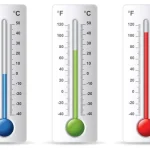Temperature conversion between Fahrenheit to Celsius scales is fundamental for global communication in science, healthcare, and weather forecasting. As Fahrenheit remains standard in the United States, Celsius dominates worldwide, particularly in scientific and environmental measurements. Mastering these conversions allows seamless adaptation between these systems, offering clarity across fields.
Fahrenheit to Celsius Conversion Overview
The conversion formula from Fahrenheit to Celsius allows for accurate temperature readings across various applications. In regions that predominantly use Fahrenheit, such as the United States, converting to Celsius helps align with international standards. The core formula is:
°C=59(°F−32)°C = \frac{5}{9} (°F – 32)°C=95(°F−32)
This equation effectively translates Fahrenheit degrees into Celsius, allowing consistent measurement in both personal and professional contexts.
The Fahrenheit Temperature Scale
The Fahrenheit scale was developed in 1724 by Daniel Gabriel Fahrenheit. Marked by its 32°F freezing point and 212°F boiling point, it remains the U.S. standard for general temperature measurement, including body temperature and household thermometers.
Key Points:
- Freezing Point: 32°F
- Boiling Point: 212°F
- Primary Usage: Predominantly in the U.S.
The Celsius Temperature Scale
Created by Swedish astronomer Anders Celsius in 1742, the Celsius scale is globally adopted, especially in scientific communities and for international weather reports. Water freezes at 0°C and boils at 100°C on this scale.
Key Points:
- Freezing Point: 0°C
- Boiling Point: 100°C
- Primary Usage: Worldwide standard, including Europe and scientific fields
Fahrenheit to Celsius Formula
To convert Fahrenheit to Celsius, the following formula is employed:
°C=59(°F−32)°C = \frac{5}{9} (°F – 32)°C=95(°F−32)
The formula subtracts 32 from the Fahrenheit value, multiplies the result by 5, and divides by 9 to yield the Celsius equivalent.
Example Calculation:
Converting 68°F to Celsius:
°C=59(68−32)=59×36=20°C°C = \frac{5}{9} (68 – 32) = \frac{5}{9} \times 36 = 20°C°C=95(68−32)=95×36=20°C
Therefore, 68°F equals 20°C.
Step-by-Step Conversion Process
For accurate conversion from Fahrenheit to Celsius, follow these three straightforward steps:

- Subtract 32: Subtract 32 from the Fahrenheit temperature.
- Multiply by 5: Multiply the result by 5.
- Divide by 9: Divide the result from step 2 by 9.
Applying these steps ensures accurate results suitable for scientific, educational, or practical uses.
Quick Conversion Trick
For an approximate conversion, a shortcut method is available:
°C≈(°F−30)2°C \approx \frac{(°F – 30)}{2}°C≈2(°F−30)
This approximation offers a rough Celsius value by subtracting 30 from Fahrenheit and dividing by 2. Though it may not be precise, it provides a quick estimation.
Example of Shortcut Conversion:
To convert 86°F using this approximation:
°C≈(86−30)2=28°C°C \approx \frac{(86 – 30)}{2} = 28°C°C≈2(86−30)=28°C
This approach estimates 86°F as approximately 28°C.
Temperature Conversion Table (°F to °C)
Here is a quick-reference table for common Fahrenheit to Celsius conversions:
| Fahrenheit (°F) | Celsius (°C) |
| 32°F | 0°C |
| 50°F | 10°C |
| 70°F | 21.11°C |
| 98.6°F | 37°C |
| 104°F | 40°C |
| 140°F | 60°C |
| 212°F | 100°C |
Solved Examples
To reinforce understanding, let’s go through specific examples:
Example 1: Convert 80°F to Celsius
Given Temperature = 80°F Using the formula, we have:
°C=59(80−32)=59×48=26.67°C°C = \frac{5}{9}(80 – 32) = \frac{5}{9} \times 48 = 26.67°C°C=95(80−32)=95×48=26.67°C
Thus, 80°F is approximately 26.67°C.
Example 2: Convert 100°F to Celsius
Given Temperature = 100°F Using the formula, we get:
°C=59(100−32)=59×68=37.78°C°C = \frac{5}{9}(100 – 32) = \frac{5}{9} \times 68 = 37.78°C°C=95(100−32)=95×68=37.78°C
So, 100°F equates to approximately 37.78°C.
Example 3: Convert 32°F (Freezing Point of Water)
Given Temperature = 32°F
°C=59(32−32)=0°C°C = \frac{5}{9}(32 – 32) = 0°C°C=95(32−32)=0°C
As expected, 32°F equals 0°C, the freezing point of water.
Frequently Asked Questions
How Do You Convert Fahrenheit to Celsius Quickly?
The shortcut approximation formula (°F−30)/2(°F – 30) / 2(°F−30)/2 offers a quick estimation of Celsius from Fahrenheit but is not as accurate as the standard formula.
What is the Celsius Equivalent of 212°F?
At 212°F, water reaches its boiling point on the Fahrenheit scale, which is equal to 100°C on the Celsius scale.
Is the Celsius Scale Always Preferred in Science?
Yes, Celsius is the preferred scale in scientific contexts due to its alignment with the metric system and the simplicity about water’s freezing and boiling points.
How Do I Convert Celsius to Fahrenheit?
To convert Celsius to Fahrenheit, use the formula:
°F=95°C+32°F = \frac{9}{5} °C + 32°F=59°C+32
Why Are There Different Temperature Scales?
Fahrenheit and Celsius emerged from historical contexts and preferences, with Fahrenheit widely used in the U.S. and Celsius adopted by most other countries and scientific communities for consistency and ease of understanding.
Conclusion
Understanding Fahrenheit and Celsius conversions is crucial for interpreting temperatures globally. The Fahrenheit-to-Celsius formula offers accuracy in fields requiring precise temperature data, from healthcare to environmental monitoring. The table, examples, and conversion techniques provided here serve as comprehensive tools for converting temperatures confidently and accurately across these two widely used scales.
Also Read:
Fantasy Team Name Generator Football
Interpersonal vs Intrapersonal
Override CSS Style in PrimeVue
Directed Graph in Python LeetCode
Dropdown from a Search Bar in Vue
JavaScript Map of the Keys Method
Centimeters to Feet and Inches
Computer Memory and File Sizes
Cup and Tablespoon Conversions
Converting Centimeters to Feet
Converting Centimeters to Inches
Converting Fahrenheit to Celsius
